Sociology 2: Analysis of Stress and Emotional Inequality Report
VerifiedAdded on 2022/09/13
|6
|1465
|15
Report
AI Summary
This report provides a sociological analysis of stress and emotional inequality, drawing on the work of scholars like Hochschild and Pearlin. It explores the core responsibilities of sociologists in investigating the conditions behind the stress process, including quality, arrangement, and tensions. The report examines the connection between emotional inequality and stress, emphasizing the role of confidence and social competence. It discusses the concept of work-life balance and its impact on stress and emotional inequality, as well as the relationship between money and happiness from a sociological viewpoint. The conclusion highlights greedy institutions, work-life imbalance, and high aspirations as key stressors contributing to emotional inequality. The report utilizes various studies and research papers to support its claims, providing a comprehensive overview of the sociological perspectives on stress and its consequences.
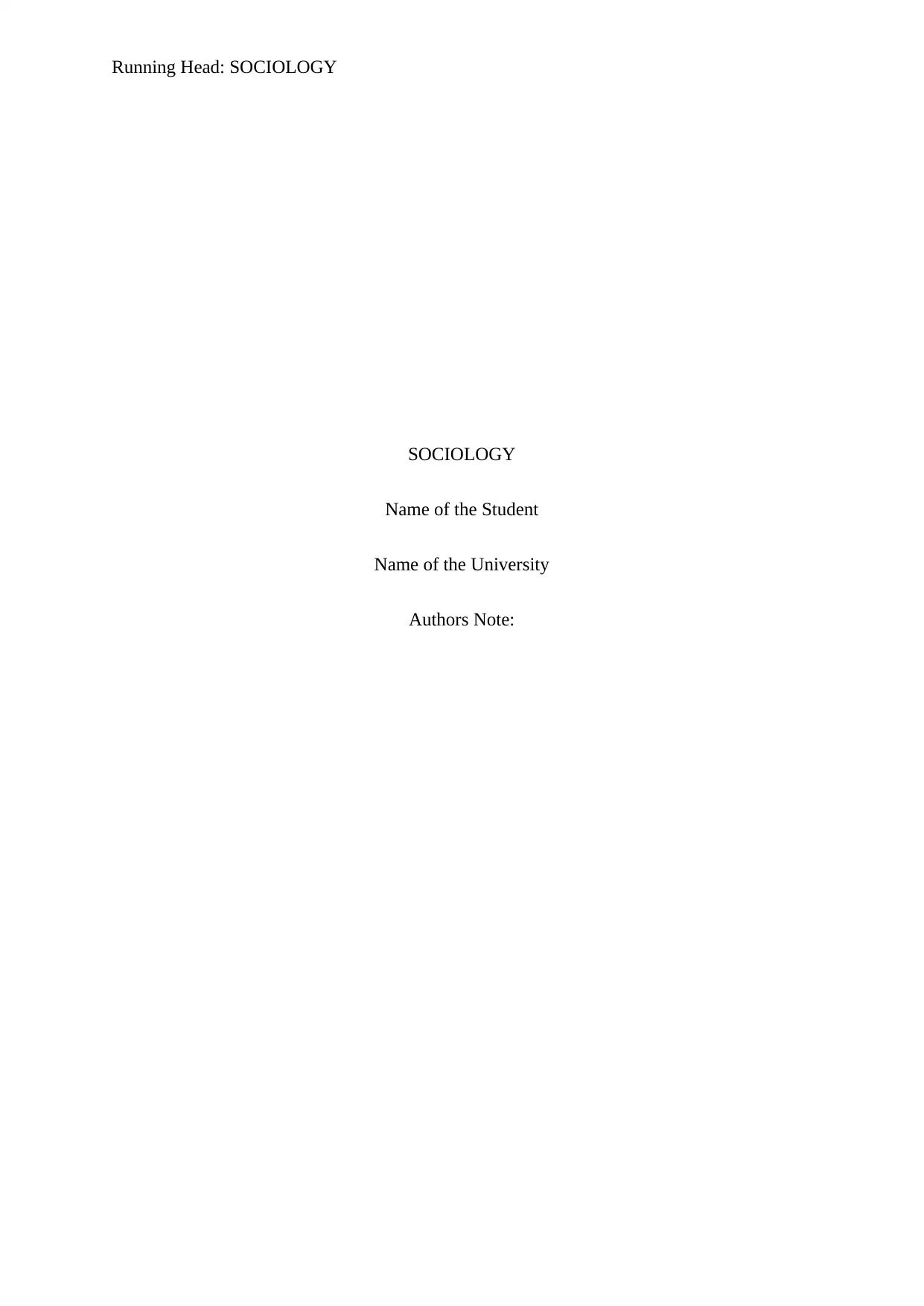
Running Head: SOCIOLOGY
SOCIOLOGY
Name of the Student
Name of the University
Authors Note:
SOCIOLOGY
Name of the Student
Name of the University
Authors Note:
Paraphrase This Document
Need a fresh take? Get an instant paraphrase of this document with our AI Paraphraser
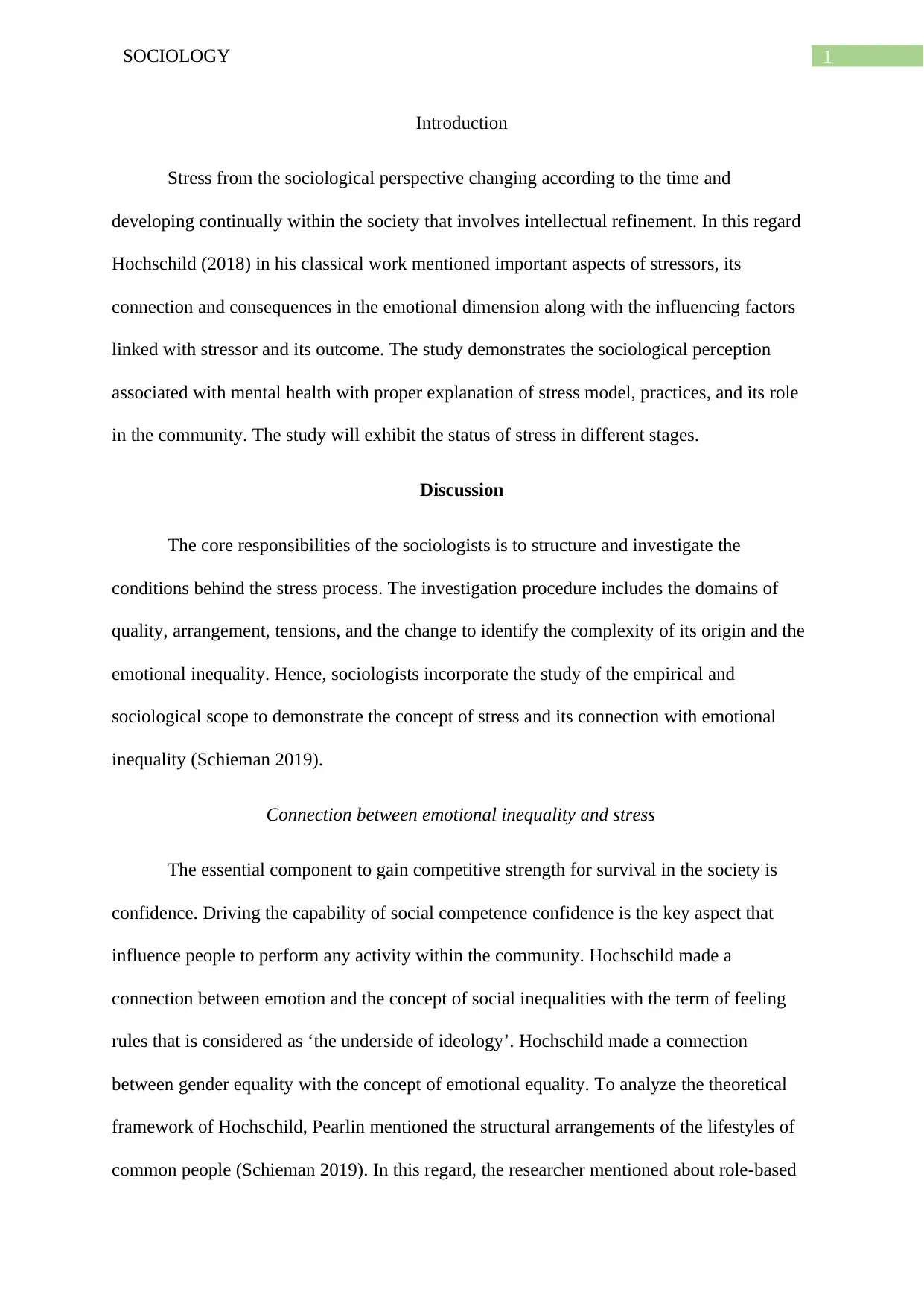
1SOCIOLOGY
Introduction
Stress from the sociological perspective changing according to the time and
developing continually within the society that involves intellectual refinement. In this regard
Hochschild (2018) in his classical work mentioned important aspects of stressors, its
connection and consequences in the emotional dimension along with the influencing factors
linked with stressor and its outcome. The study demonstrates the sociological perception
associated with mental health with proper explanation of stress model, practices, and its role
in the community. The study will exhibit the status of stress in different stages.
Discussion
The core responsibilities of the sociologists is to structure and investigate the
conditions behind the stress process. The investigation procedure includes the domains of
quality, arrangement, tensions, and the change to identify the complexity of its origin and the
emotional inequality. Hence, sociologists incorporate the study of the empirical and
sociological scope to demonstrate the concept of stress and its connection with emotional
inequality (Schieman 2019).
Connection between emotional inequality and stress
The essential component to gain competitive strength for survival in the society is
confidence. Driving the capability of social competence confidence is the key aspect that
influence people to perform any activity within the community. Hochschild made a
connection between emotion and the concept of social inequalities with the term of feeling
rules that is considered as ‘the underside of ideology’. Hochschild made a connection
between gender equality with the concept of emotional equality. To analyze the theoretical
framework of Hochschild, Pearlin mentioned the structural arrangements of the lifestyles of
common people (Schieman 2019). In this regard, the researcher mentioned about role-based
Introduction
Stress from the sociological perspective changing according to the time and
developing continually within the society that involves intellectual refinement. In this regard
Hochschild (2018) in his classical work mentioned important aspects of stressors, its
connection and consequences in the emotional dimension along with the influencing factors
linked with stressor and its outcome. The study demonstrates the sociological perception
associated with mental health with proper explanation of stress model, practices, and its role
in the community. The study will exhibit the status of stress in different stages.
Discussion
The core responsibilities of the sociologists is to structure and investigate the
conditions behind the stress process. The investigation procedure includes the domains of
quality, arrangement, tensions, and the change to identify the complexity of its origin and the
emotional inequality. Hence, sociologists incorporate the study of the empirical and
sociological scope to demonstrate the concept of stress and its connection with emotional
inequality (Schieman 2019).
Connection between emotional inequality and stress
The essential component to gain competitive strength for survival in the society is
confidence. Driving the capability of social competence confidence is the key aspect that
influence people to perform any activity within the community. Hochschild made a
connection between emotion and the concept of social inequalities with the term of feeling
rules that is considered as ‘the underside of ideology’. Hochschild made a connection
between gender equality with the concept of emotional equality. To analyze the theoretical
framework of Hochschild, Pearlin mentioned the structural arrangements of the lifestyles of
common people (Schieman 2019). In this regard, the researcher mentioned about role-based
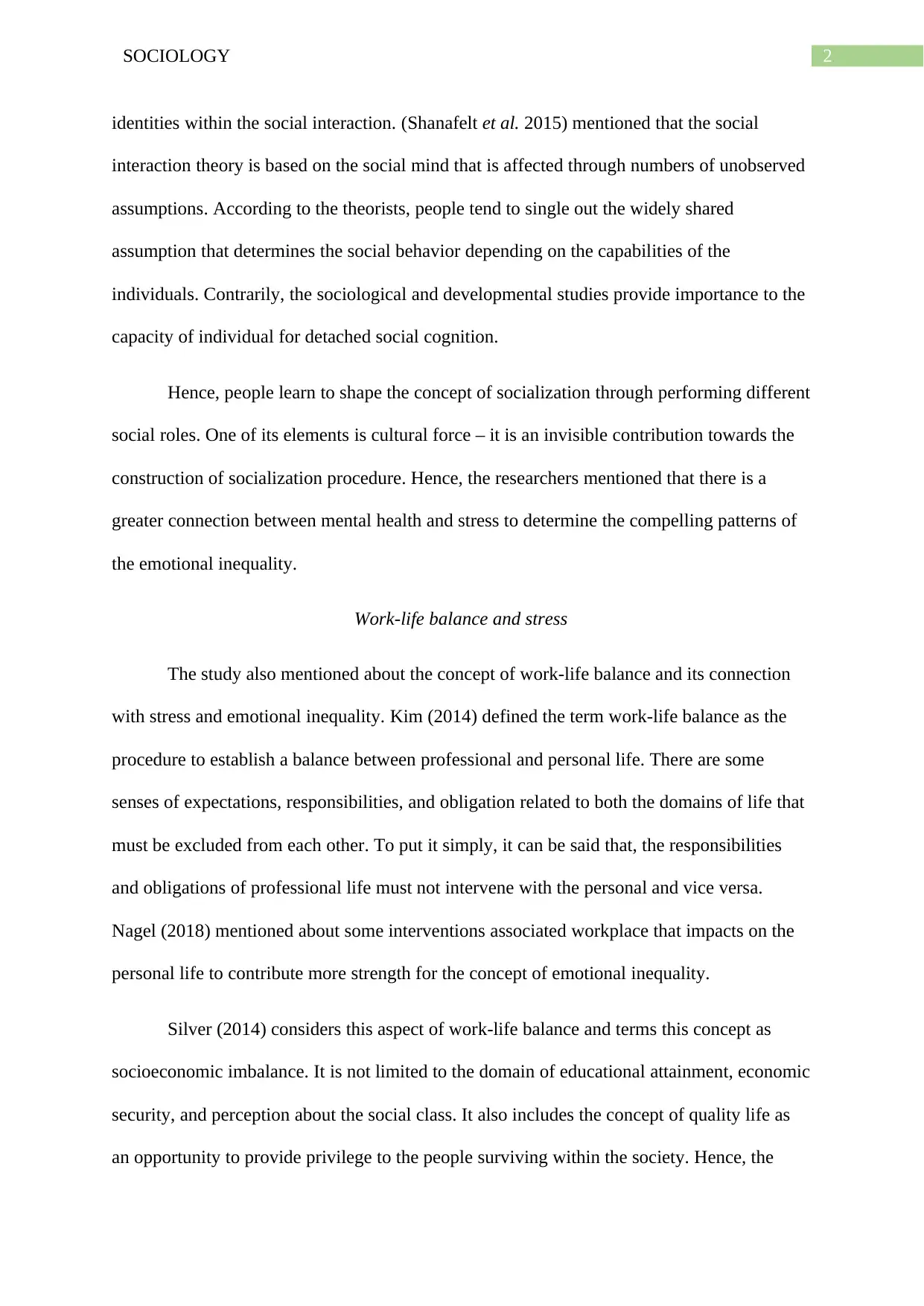
2SOCIOLOGY
identities within the social interaction. (Shanafelt et al. 2015) mentioned that the social
interaction theory is based on the social mind that is affected through numbers of unobserved
assumptions. According to the theorists, people tend to single out the widely shared
assumption that determines the social behavior depending on the capabilities of the
individuals. Contrarily, the sociological and developmental studies provide importance to the
capacity of individual for detached social cognition.
Hence, people learn to shape the concept of socialization through performing different
social roles. One of its elements is cultural force – it is an invisible contribution towards the
construction of socialization procedure. Hence, the researchers mentioned that there is a
greater connection between mental health and stress to determine the compelling patterns of
the emotional inequality.
Work-life balance and stress
The study also mentioned about the concept of work-life balance and its connection
with stress and emotional inequality. Kim (2014) defined the term work-life balance as the
procedure to establish a balance between professional and personal life. There are some
senses of expectations, responsibilities, and obligation related to both the domains of life that
must be excluded from each other. To put it simply, it can be said that, the responsibilities
and obligations of professional life must not intervene with the personal and vice versa.
Nagel (2018) mentioned about some interventions associated workplace that impacts on the
personal life to contribute more strength for the concept of emotional inequality.
Silver (2014) considers this aspect of work-life balance and terms this concept as
socioeconomic imbalance. It is not limited to the domain of educational attainment, economic
security, and perception about the social class. It also includes the concept of quality life as
an opportunity to provide privilege to the people surviving within the society. Hence, the
identities within the social interaction. (Shanafelt et al. 2015) mentioned that the social
interaction theory is based on the social mind that is affected through numbers of unobserved
assumptions. According to the theorists, people tend to single out the widely shared
assumption that determines the social behavior depending on the capabilities of the
individuals. Contrarily, the sociological and developmental studies provide importance to the
capacity of individual for detached social cognition.
Hence, people learn to shape the concept of socialization through performing different
social roles. One of its elements is cultural force – it is an invisible contribution towards the
construction of socialization procedure. Hence, the researchers mentioned that there is a
greater connection between mental health and stress to determine the compelling patterns of
the emotional inequality.
Work-life balance and stress
The study also mentioned about the concept of work-life balance and its connection
with stress and emotional inequality. Kim (2014) defined the term work-life balance as the
procedure to establish a balance between professional and personal life. There are some
senses of expectations, responsibilities, and obligation related to both the domains of life that
must be excluded from each other. To put it simply, it can be said that, the responsibilities
and obligations of professional life must not intervene with the personal and vice versa.
Nagel (2018) mentioned about some interventions associated workplace that impacts on the
personal life to contribute more strength for the concept of emotional inequality.
Silver (2014) considers this aspect of work-life balance and terms this concept as
socioeconomic imbalance. It is not limited to the domain of educational attainment, economic
security, and perception about the social class. It also includes the concept of quality life as
an opportunity to provide privilege to the people surviving within the society. Hence, the
⊘ This is a preview!⊘
Do you want full access?
Subscribe today to unlock all pages.

Trusted by 1+ million students worldwide
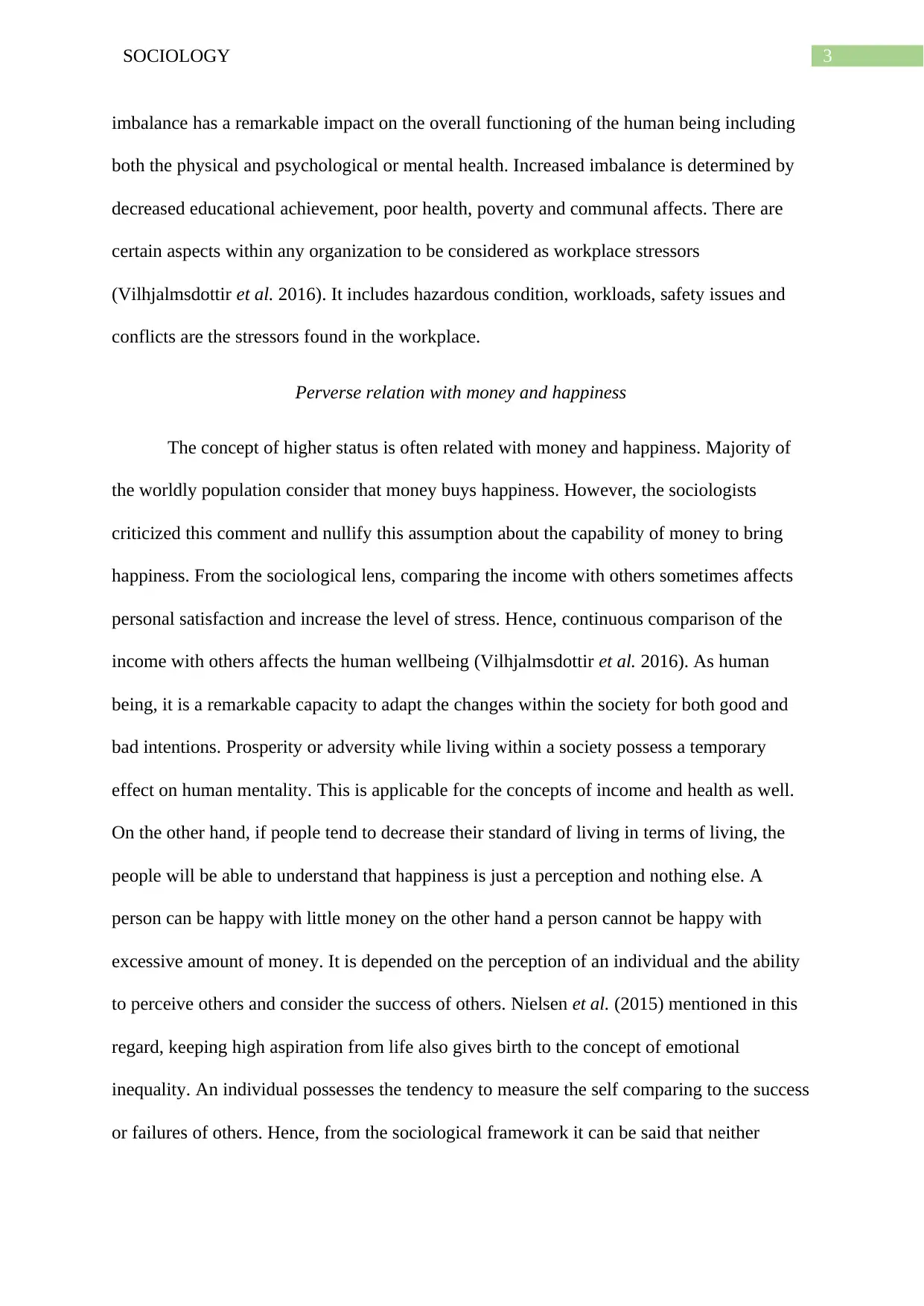
3SOCIOLOGY
imbalance has a remarkable impact on the overall functioning of the human being including
both the physical and psychological or mental health. Increased imbalance is determined by
decreased educational achievement, poor health, poverty and communal affects. There are
certain aspects within any organization to be considered as workplace stressors
(Vilhjalmsdottir et al. 2016). It includes hazardous condition, workloads, safety issues and
conflicts are the stressors found in the workplace.
Perverse relation with money and happiness
The concept of higher status is often related with money and happiness. Majority of
the worldly population consider that money buys happiness. However, the sociologists
criticized this comment and nullify this assumption about the capability of money to bring
happiness. From the sociological lens, comparing the income with others sometimes affects
personal satisfaction and increase the level of stress. Hence, continuous comparison of the
income with others affects the human wellbeing (Vilhjalmsdottir et al. 2016). As human
being, it is a remarkable capacity to adapt the changes within the society for both good and
bad intentions. Prosperity or adversity while living within a society possess a temporary
effect on human mentality. This is applicable for the concepts of income and health as well.
On the other hand, if people tend to decrease their standard of living in terms of living, the
people will be able to understand that happiness is just a perception and nothing else. A
person can be happy with little money on the other hand a person cannot be happy with
excessive amount of money. It is depended on the perception of an individual and the ability
to perceive others and consider the success of others. Nielsen et al. (2015) mentioned in this
regard, keeping high aspiration from life also gives birth to the concept of emotional
inequality. An individual possesses the tendency to measure the self comparing to the success
or failures of others. Hence, from the sociological framework it can be said that neither
imbalance has a remarkable impact on the overall functioning of the human being including
both the physical and psychological or mental health. Increased imbalance is determined by
decreased educational achievement, poor health, poverty and communal affects. There are
certain aspects within any organization to be considered as workplace stressors
(Vilhjalmsdottir et al. 2016). It includes hazardous condition, workloads, safety issues and
conflicts are the stressors found in the workplace.
Perverse relation with money and happiness
The concept of higher status is often related with money and happiness. Majority of
the worldly population consider that money buys happiness. However, the sociologists
criticized this comment and nullify this assumption about the capability of money to bring
happiness. From the sociological lens, comparing the income with others sometimes affects
personal satisfaction and increase the level of stress. Hence, continuous comparison of the
income with others affects the human wellbeing (Vilhjalmsdottir et al. 2016). As human
being, it is a remarkable capacity to adapt the changes within the society for both good and
bad intentions. Prosperity or adversity while living within a society possess a temporary
effect on human mentality. This is applicable for the concepts of income and health as well.
On the other hand, if people tend to decrease their standard of living in terms of living, the
people will be able to understand that happiness is just a perception and nothing else. A
person can be happy with little money on the other hand a person cannot be happy with
excessive amount of money. It is depended on the perception of an individual and the ability
to perceive others and consider the success of others. Nielsen et al. (2015) mentioned in this
regard, keeping high aspiration from life also gives birth to the concept of emotional
inequality. An individual possesses the tendency to measure the self comparing to the success
or failures of others. Hence, from the sociological framework it can be said that neither
Paraphrase This Document
Need a fresh take? Get an instant paraphrase of this document with our AI Paraphraser
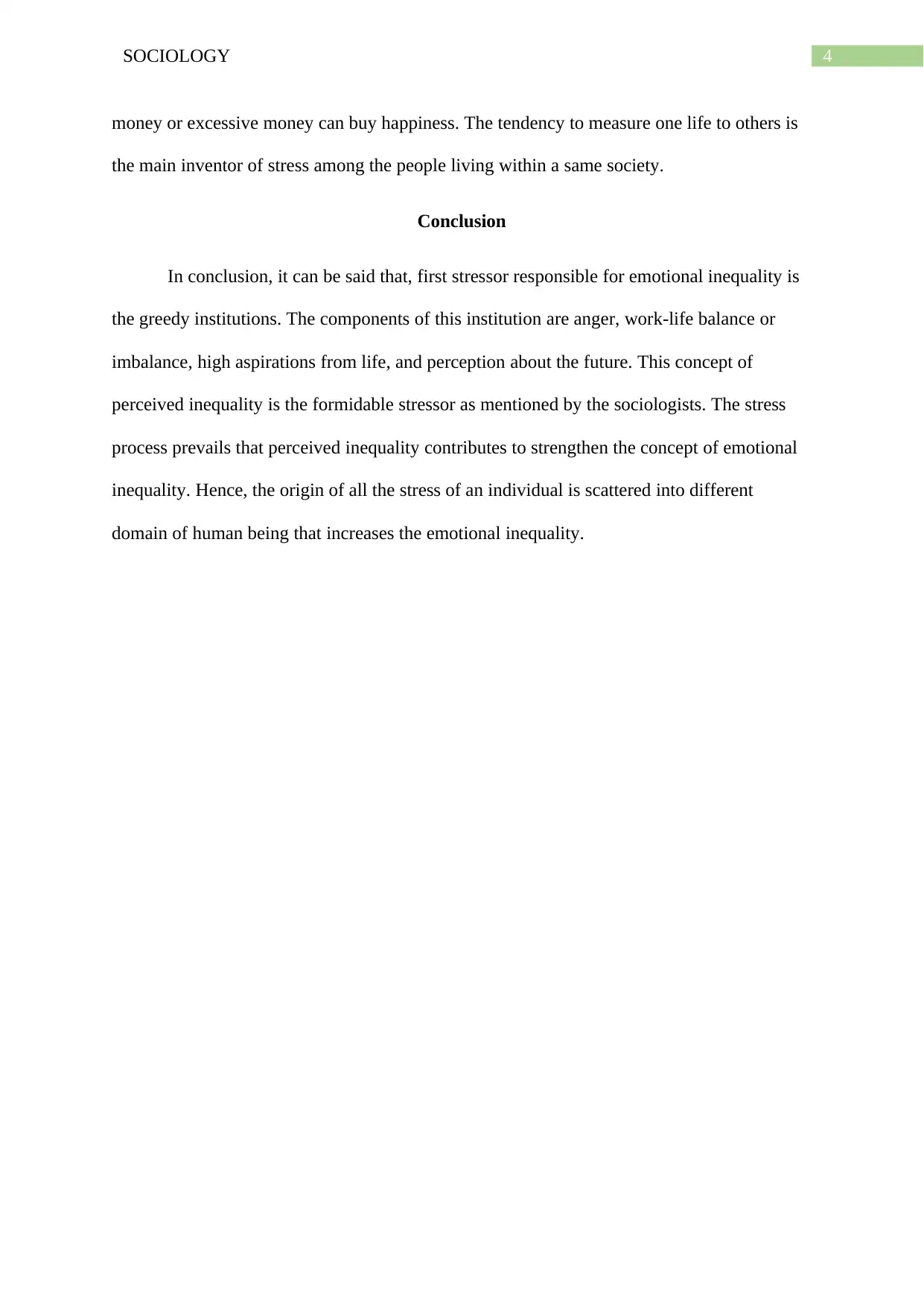
4SOCIOLOGY
money or excessive money can buy happiness. The tendency to measure one life to others is
the main inventor of stress among the people living within a same society.
Conclusion
In conclusion, it can be said that, first stressor responsible for emotional inequality is
the greedy institutions. The components of this institution are anger, work-life balance or
imbalance, high aspirations from life, and perception about the future. This concept of
perceived inequality is the formidable stressor as mentioned by the sociologists. The stress
process prevails that perceived inequality contributes to strengthen the concept of emotional
inequality. Hence, the origin of all the stress of an individual is scattered into different
domain of human being that increases the emotional inequality.
money or excessive money can buy happiness. The tendency to measure one life to others is
the main inventor of stress among the people living within a same society.
Conclusion
In conclusion, it can be said that, first stressor responsible for emotional inequality is
the greedy institutions. The components of this institution are anger, work-life balance or
imbalance, high aspirations from life, and perception about the future. This concept of
perceived inequality is the formidable stressor as mentioned by the sociologists. The stress
process prevails that perceived inequality contributes to strengthen the concept of emotional
inequality. Hence, the origin of all the stress of an individual is scattered into different
domain of human being that increases the emotional inequality.
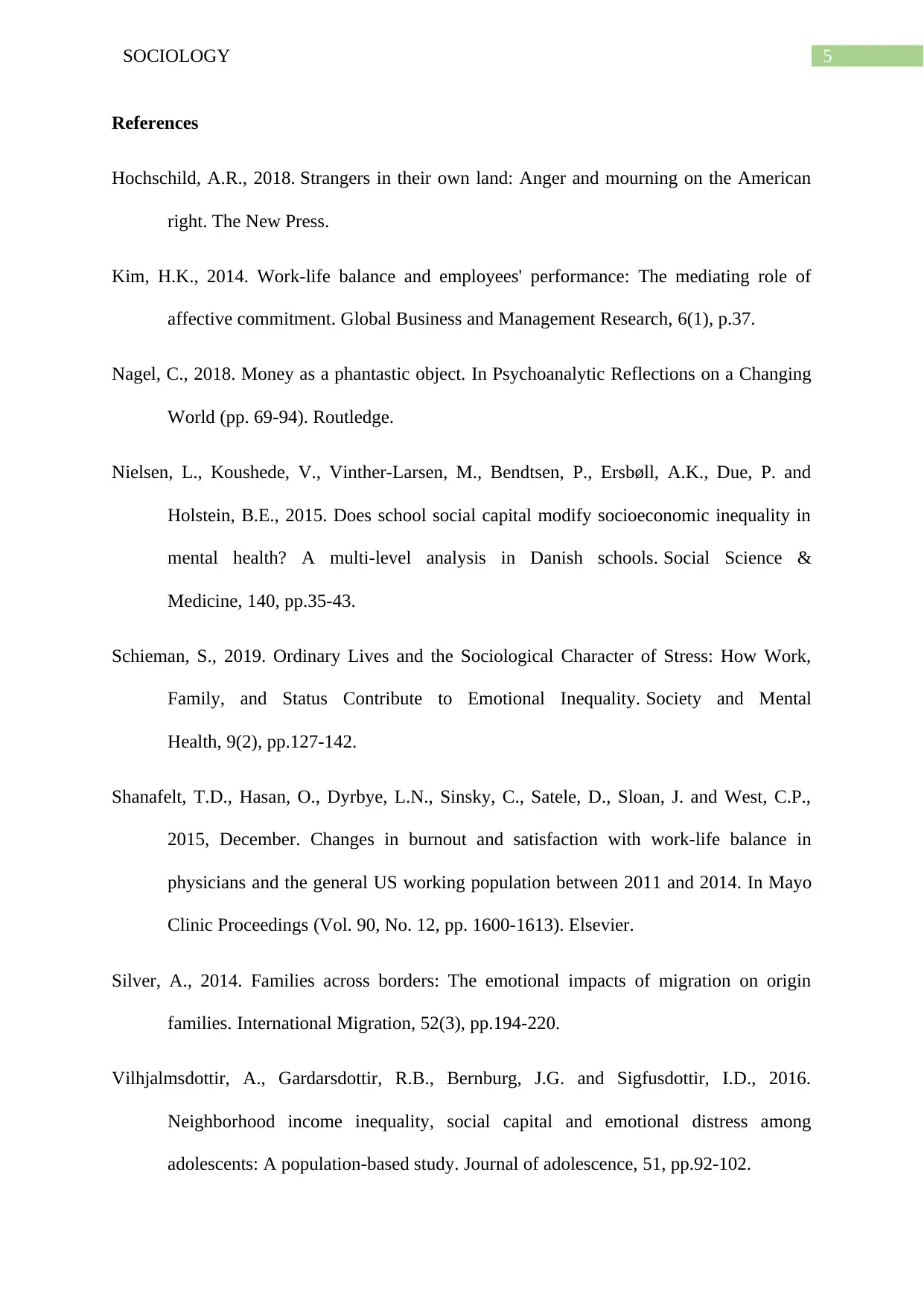
5SOCIOLOGY
References
Hochschild, A.R., 2018. Strangers in their own land: Anger and mourning on the American
right. The New Press.
Kim, H.K., 2014. Work-life balance and employees' performance: The mediating role of
affective commitment. Global Business and Management Research, 6(1), p.37.
Nagel, C., 2018. Money as a phantastic object. In Psychoanalytic Reflections on a Changing
World (pp. 69-94). Routledge.
Nielsen, L., Koushede, V., Vinther-Larsen, M., Bendtsen, P., Ersbøll, A.K., Due, P. and
Holstein, B.E., 2015. Does school social capital modify socioeconomic inequality in
mental health? A multi-level analysis in Danish schools. Social Science &
Medicine, 140, pp.35-43.
Schieman, S., 2019. Ordinary Lives and the Sociological Character of Stress: How Work,
Family, and Status Contribute to Emotional Inequality. Society and Mental
Health, 9(2), pp.127-142.
Shanafelt, T.D., Hasan, O., Dyrbye, L.N., Sinsky, C., Satele, D., Sloan, J. and West, C.P.,
2015, December. Changes in burnout and satisfaction with work-life balance in
physicians and the general US working population between 2011 and 2014. In Mayo
Clinic Proceedings (Vol. 90, No. 12, pp. 1600-1613). Elsevier.
Silver, A., 2014. Families across borders: The emotional impacts of migration on origin
families. International Migration, 52(3), pp.194-220.
Vilhjalmsdottir, A., Gardarsdottir, R.B., Bernburg, J.G. and Sigfusdottir, I.D., 2016.
Neighborhood income inequality, social capital and emotional distress among
adolescents: A population-based study. Journal of adolescence, 51, pp.92-102.
References
Hochschild, A.R., 2018. Strangers in their own land: Anger and mourning on the American
right. The New Press.
Kim, H.K., 2014. Work-life balance and employees' performance: The mediating role of
affective commitment. Global Business and Management Research, 6(1), p.37.
Nagel, C., 2018. Money as a phantastic object. In Psychoanalytic Reflections on a Changing
World (pp. 69-94). Routledge.
Nielsen, L., Koushede, V., Vinther-Larsen, M., Bendtsen, P., Ersbøll, A.K., Due, P. and
Holstein, B.E., 2015. Does school social capital modify socioeconomic inequality in
mental health? A multi-level analysis in Danish schools. Social Science &
Medicine, 140, pp.35-43.
Schieman, S., 2019. Ordinary Lives and the Sociological Character of Stress: How Work,
Family, and Status Contribute to Emotional Inequality. Society and Mental
Health, 9(2), pp.127-142.
Shanafelt, T.D., Hasan, O., Dyrbye, L.N., Sinsky, C., Satele, D., Sloan, J. and West, C.P.,
2015, December. Changes in burnout and satisfaction with work-life balance in
physicians and the general US working population between 2011 and 2014. In Mayo
Clinic Proceedings (Vol. 90, No. 12, pp. 1600-1613). Elsevier.
Silver, A., 2014. Families across borders: The emotional impacts of migration on origin
families. International Migration, 52(3), pp.194-220.
Vilhjalmsdottir, A., Gardarsdottir, R.B., Bernburg, J.G. and Sigfusdottir, I.D., 2016.
Neighborhood income inequality, social capital and emotional distress among
adolescents: A population-based study. Journal of adolescence, 51, pp.92-102.
⊘ This is a preview!⊘
Do you want full access?
Subscribe today to unlock all pages.

Trusted by 1+ million students worldwide
1 out of 6
Related Documents
Your All-in-One AI-Powered Toolkit for Academic Success.
+13062052269
info@desklib.com
Available 24*7 on WhatsApp / Email
![[object Object]](/_next/static/media/star-bottom.7253800d.svg)
Unlock your academic potential
Copyright © 2020–2025 A2Z Services. All Rights Reserved. Developed and managed by ZUCOL.




